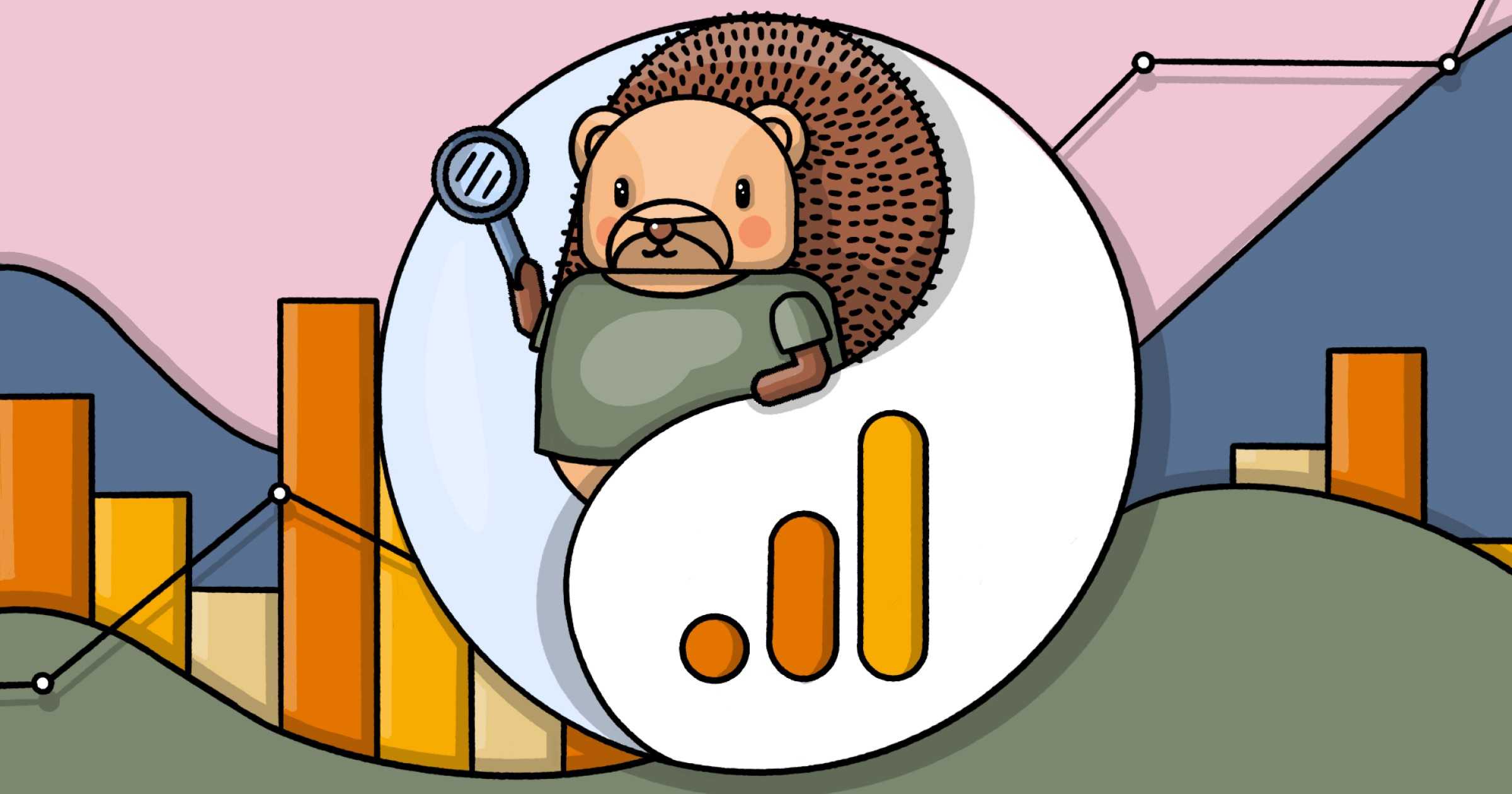In-depth: PostHog vs Google Analytics 4
Oct 17, 2023

On this page
- How is PostHog different to Google Analytics?
- 1. PostHog does more than analytics
- 2. PostHog is built for engineers
- 3. PostHog is open source and transparent
- Core features
- Analytics features
- Apps and integrations
- Privacy, compliance, and security
- Frequently asked questions
- Does PostHog have reports, dimensions, and other GA4 features?
- How much do PostHog and Google Analytics cost?
- Does PostHog offer a free trial?
- Are there discounts for nonprofits and startups?
Want to understand how PostHog and Google Analytics 4 (GA4) are different? Here's the short answer:
Google Analytics is primarily designed for marketers who want to analyze landing pages, compare marketing channels, and return on ad spend.
PostHog is an all-in-one platform built to help engineers understand users and create better products. It includes analytics and a whole bunch more, such as session replays, feature flags, A/B testing, and surveys.
In this article we’ll explore these differences in more detail, and take a deep dive into the analytics features of both.
How is PostHog different to Google Analytics?
1. PostHog does more than analytics
Analytics is a core part of our platform, but it's just one component in a set of important tools for product teams. PostHog enables you to collect feedback with surveys, understand user behavior with session replays, test changes with A/B tests, and deploy changes with feature flags.
2. PostHog is built for engineers
Anyone can use PostHog – just ask our marketing team – but PostHog is designed to meet the needs of engineers. Our goal is to help developers be better at product.
3. PostHog is open source and transparent
PostHog is built with transparency at its core. We work in the open and give full access to our source code, and enable you to build integrations and other services on top of the product. You can even give feedback on our public roadmap.
Core features
PostHog offers a wider selection of features than GA4, which focuses solely on analytics. This makes PostHog better suited for teams who are building products.
| GA4 | PostHog | |
Analytics Custom trends, funnels, and retention analysis | ✔ | ✔ |
Session replays Watch real users use your product; diagnose bugs | ✖ | ✔ |
Heatmaps Visualize where users click in your app or website | ✖ | ✔ |
Feature flags Roll out features safely; toggle features for cohorts or individuals | ✖ | ✔ |
Surveys Ask users for qualitative feedback and gather responses | ✖ | ✔ |
A/B testing Test changes and analyze impact | ✖ | ✔ |
Apps and integrations Push and pull data to other destinations | ✔ | ✔ |
Open source Full access to source code and transparent roadmap | ✖ | ✔ |
Analytics features
Both GA4 and PostHog offer analytics, but what they offer is drastically different.
GA4 has better features for calculating monetization and ROI on Google Ads and other marketing campaigns. This is particularly helpful for e-commerce websites.
PostHog, on the other hand, focuses on providing insights on product and feature usage. The biggest difference is group analytics, which enable you to track metrics at an account or company level – a feature which GA4 lacks. This makes PostHog especially useful for building B2B SaaS products.
| GA4 | PostHog | |
Group analytics Track metrics at account or company level | ✖ | ✔ |
Monetization analytics Track purchase value, LTV, and other revenue metrics | ✔ | ✖ |
Advertising analytics Track ROI on Google Ads and other marketing campaigns | ✔ | ✖ |
Real-time reporting Monitor activity on your site or app as it happens. | ✔ | ✖ |
Predictive insights AI-powered alerts when metrics change | ✔ | ✖ |
Traffic breakdown Gain insights into where your visitors and conversions are coming from | ✔ | ✔ |
User profiles View user demographic data such as country, language, and device type | ✔ | ✔ |
UTM tracking Track marketing campaigns with UTM tags | ✔ | ✔ |
Funnels Visualize conversion rates and drop-offs | ✔ | ✔ |
User paths Track user flows and where they drop-off | ✔ | ✔ |
Retention Analyze user and revenue retention | ✔ | ✔ |
PostHog also offers the following features to help you understand how people are using your product:
| GA | PostHog | |
Correlation analysis Automatically highlight factors affecting funnel conversion rates | ✖ | ✔ |
Lifecycle insights Break down events from new, returning, resurrecting, and dormant users | ✖ | ✔ |
Stickiness insights See how many times users perform an event in a period of time | ✖ | ✔ |
Formulas Use custom formulas to create unique insights | ✖ | ✔ |
SQL access Write your own queries in SQL | Requires BigQuery | ✔ |
Toolbar View insights on your live website or app with an overlay | ✖ | ✔ |
Apps and integrations
Because PostHog is built to be your single source of truth for viewing data, it's very simple to import data from other sources.
In contrast, it's hard to import data into GA4 because:
- The data type and format you're allowed to import into GA4 is restrictive.
- You either need to constantly upload CSV files manually, or set up an SFTP server to automatically do this for you.
However, GA4 is well integrated into the Google ecosystem, making it easy to transfer data between it and other Google products.
Below is a comparison of some of the most popular apps. For a full list of PostHog’s available integrations, check our app directory.
| GA | PostHog | |
Zapier Trigger Zaps with events | ✔ | ✔ |
Hubspot Sync event and person data | ✖ | ✔ |
Salesforce Sync event and person data | ✖ | ✔ |
Intercom Extract and load data to external platforms | ✖ | ✔ |
Customer.io Sync data between platforms | ✖ | ✔ |
Sentry Ingest Sentry errors for analysis | ✖ | ✔ |
Google Ads Track Google ad ROI | ✔ | ✖ |
Google Search Console Seamlessly import data from your search console | ✔ | ✖ |
Google BigQuery Automatically export data to BigQuery | ✔ | ✔ |
Google Looker Studio Visualize events in Looker dashboards | ✔ | ✖ |
Slack Receive notifications about new data | Requires 3rd party integration | ✔ |
Discord Receive notifications about new data | Requires 3rd party integration | ✔ |
MS Teams Receive notifications about new data | Requires 3rd party integration | ✔ |
One unique advantage of PostHog is that, because it is open source, it’s easy to create your own apps and integrations. This is useful if you’re, for example, using niche software in your stack that hasn’t been widely adopted, or if you require a direct integration between PostHog and your product.
Privacy, compliance, and security
PostHog makes GDPR compliance easy by letting you choose where your data is hosted: EU or US. PostHog also offers cookie-less tracking, and a variety of security options to keep your data secure.
GA4 also offers various privacy controls, but you can't choose where your data is stored.
| GA | PostHog | |
EU hosting available | ✖ | ✔ |
Data anonymization | ✔ | ✔ |
Cookie-less tracking option | ✔ | ✔ |
Security certification | ISO 27001 | SOC 2 |
Role-based access control | ✔ | Feature flags only |
SAML/SSO available | ✔ | ✔ |
2FA available | ✔ | ✔ |
Frequently asked questions
Does PostHog have reports, dimensions, and other GA4 features?
Yes, PostHog has much of the same functionality as Google Analytics, but much of it is named differently. Here’s a quick comparison of the two:
| GA name | PostHog equivalent | |
| Report | Insight | Query and filter analytics data and visualize results. Types include trends, funnels, retention, and more. |
| Dimensions | Properties | Additional details added to events, persons, and groups such as location, browser, and status. |
| View | Dashboard | A collection of insights displayed together. |
| Audience | Persons | Represents a user or set of users who create events, potentially filtered by properties or behaviors. |
| Segment | Filter | A way to create a subset of your data. |
| Goals and conversions | Actions | An event or collection of events representing a target behavior. |
| Client ID | Distinct ID | A unique identifier for a user. |
| Measurement ID | Project API key | The unique identifier for your project, used to send data to your PostHog instance. |
Familiar with Google Analytics and want more information on how to use PostHog? We've written a guide to PostHog for Google Analytics users.
How much do PostHog and Google Analytics cost?
GA4 has a free tier which should be sufficient for most startups and scale-ups. Larger enterprises with higher data collection and export requirements will need to upgrade to GA360, which starts at $50,000 per year.
A good rule of thumb is that if you're exporting more than 1 million events per day, or querying data with more than 10 million events, you'll need to upgrade to GA360 (see a full breakdown on their website).
PostHog has transparent pricing based on the usage. It’s free to get started and completely free for the first 1 million analytics events. After this free monthly allowance, you'll pay $0.00031/event, and PostHog charges progressively less the more you use. We recommend trying our pricing calculator and reading our guide for estimating your usage.
Does PostHog offer a free trial?
With PostHog, you don’t need a free trial — it’s free to get started, with a generous monthly allowance of events, replays, and feature flag requests. If you’re within this allowance, PostHog is free to use forever.
Are there discounts for nonprofits and startups?
Yes, PostHog offers both. Nonprofit organizations can contact our team and are usually eligible for a 50% discount, while startups can sign up for $50,000 of free credit (and a host of other perks) in the PostHog for Startups program.
Ready to find out more?
